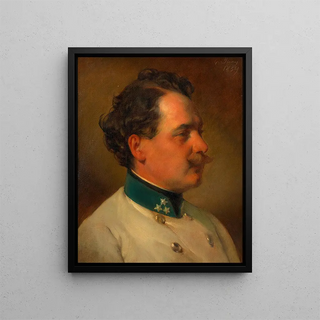Art print | Andreas Amerling as Captain of the Infantry Regiment No. 3, artist's brother - Friedrich von Amerling


View from behind

Frame (optional)
Andreas Amerling art print in the role of the captain of the infantry regiment n° 3, brother of the artist - Friedrich von Amerling – Captivating introduction
In the vibrant universe of art, some works manage to capture the essence of an era while revealing the subtleties of human relationships. The art print of Andreas Amerling in the role of the captain of the infantry regiment n° 3, brother of the artist - Friedrich von Amerling, is undoubtedly one of these remarkable pieces. This piece is not limited to a simple portrait; it embodies a family story and a testament to the artistic heritage that spans generations. Through the piercing gaze of the captain, the viewer is invited to delve into the military world of the 19th century, while discovering the depth of the fraternal bonds that unite the two men.
Style and uniqueness of the work
The work stands out for its striking realism and harmonious composition. Friedrich von Amerling, master of the portrait, deploys a palette of rich and nuanced colors that give his subject an almost palpable life. The captain, dressed in his dress uniform, stands with a presence that evokes both pride and melancholy. The meticulous details, such as the embroidery on his uniform and the shine of his decorations, testify to undeniable technical mastery. The light, skillfully orchestrated, highlights the facial features while creating an intimate atmosphere. This portrait does not merely depict a man; it evokes an era, a social status, but also a deep emotion. The singularity of this art print lies in its ability to transcend time and establish a dialogue between the past and the present.
The artist and his influence
Friedrich von Amerling, born in 1803 in Vienna, is one of the most influential portrait artists of his time. Trained at the Vienna Academy of Fine Arts, he mastered the balance between tradition and innovation, drawing inspiration from realism while incorporating romantic elements. His work marked the Austrian artistic landscape of the 19th century, and his style influenced many artists who followed him. By painting his brother Andreas,

Matte finish

View from behind

Frame (optional)
Andreas Amerling art print in the role of the captain of the infantry regiment n° 3, brother of the artist - Friedrich von Amerling – Captivating introduction
In the vibrant universe of art, some works manage to capture the essence of an era while revealing the subtleties of human relationships. The art print of Andreas Amerling in the role of the captain of the infantry regiment n° 3, brother of the artist - Friedrich von Amerling, is undoubtedly one of these remarkable pieces. This piece is not limited to a simple portrait; it embodies a family story and a testament to the artistic heritage that spans generations. Through the piercing gaze of the captain, the viewer is invited to delve into the military world of the 19th century, while discovering the depth of the fraternal bonds that unite the two men.
Style and uniqueness of the work
The work stands out for its striking realism and harmonious composition. Friedrich von Amerling, master of the portrait, deploys a palette of rich and nuanced colors that give his subject an almost palpable life. The captain, dressed in his dress uniform, stands with a presence that evokes both pride and melancholy. The meticulous details, such as the embroidery on his uniform and the shine of his decorations, testify to undeniable technical mastery. The light, skillfully orchestrated, highlights the facial features while creating an intimate atmosphere. This portrait does not merely depict a man; it evokes an era, a social status, but also a deep emotion. The singularity of this art print lies in its ability to transcend time and establish a dialogue between the past and the present.
The artist and his influence
Friedrich von Amerling, born in 1803 in Vienna, is one of the most influential portrait artists of his time. Trained at the Vienna Academy of Fine Arts, he mastered the balance between tradition and innovation, drawing inspiration from realism while incorporating romantic elements. His work marked the Austrian artistic landscape of the 19th century, and his style influenced many artists who followed him. By painting his brother Andreas,






